Where Should I Put My Sink and Hob?
Sinks and hobs are key kitchen elements and will determine your layout. But how to get their locations right?
Kate Burt
26 February 2021
Houzz UK. I'm a journalist and editor, previously for the Independent, Guardian and various magazines. I'm now excited to part of the editorial team at Houzz UK & Ireland, bringing the best of British and Irish design, interiors and architecture to Houzz.com.
Houzz UK. I'm a journalist and editor, previously for the Independent, Guardian and... More
Should your sink overlook the garden? (And what if it can’t?) Can a hob go under a window? And what are the pros and cons for putting either item into an island? These questions and more are answered by our expert panel.
Professional advice from: Hannah Raven of Raven Kitchen Design; Dale Williams of Kettle Co Kitchens; Claudia Dorsch of Claudia Dorsch Interior Design
Professional advice from: Hannah Raven of Raven Kitchen Design; Dale Williams of Kettle Co Kitchens; Claudia Dorsch of Claudia Dorsch Interior Design
How important is it to get the sink and hob in the right locations?
“It’s very important,” Hannah Raven says. Dale Williams agrees. “The locations of the hob and sink form some of the defining considerations for any design, along with storage – including chilled – and prep area,” he says. “The positioning of these four items can impact not just on how efficient the kitchen is to use, but also on the whole feel and aesthetic of the room.”
“The kitchen triangle concept stipulates the sink, hob and fridge should be located in a triangle with nothing interrupting the flow from one to another,” Claudia Dorsch says. “This is still a useful idea – circulation and traffic flow in any room is important to bear in mind – but in addition to that, we consider the size, shape, proportion and period style of the property, as well as the client lifestyle and circumstances of using the space. A family of five will have different demands on their kitchen from a single occupant.”
“Our job as designers is to help clients identify how they want to use their kitchen,” Dale agrees. “For example, if a customer’s priority is to have a space to entertain in, then we will suggest positioning key elements to be forward-facing, so the cook can easily interact with guests.”
“It’s very important,” Hannah Raven says. Dale Williams agrees. “The locations of the hob and sink form some of the defining considerations for any design, along with storage – including chilled – and prep area,” he says. “The positioning of these four items can impact not just on how efficient the kitchen is to use, but also on the whole feel and aesthetic of the room.”
“The kitchen triangle concept stipulates the sink, hob and fridge should be located in a triangle with nothing interrupting the flow from one to another,” Claudia Dorsch says. “This is still a useful idea – circulation and traffic flow in any room is important to bear in mind – but in addition to that, we consider the size, shape, proportion and period style of the property, as well as the client lifestyle and circumstances of using the space. A family of five will have different demands on their kitchen from a single occupant.”
“Our job as designers is to help clients identify how they want to use their kitchen,” Dale agrees. “For example, if a customer’s priority is to have a space to entertain in, then we will suggest positioning key elements to be forward-facing, so the cook can easily interact with guests.”
Which questions should you ask yourself to help determine the best positions?
- “Is the room open-plan and used for living and entertaining?” Hannah says. “If so, then I would always try to keep the sink further away from the social part of the room. This way, any dirty dishes that pile up won’t be in full view of your guests.”
- Are you prepared to shift existing plumbing? “If clients don’t want the extra work of changing where the plumbing is,” Hannah says, “then it would be best to position the sink where it was in the previous kitchen.”
- Will there be sufficient space around the hob? “With the new technology of hobs, with downdraught extractor built in, the possibilities of where you can position your hob are far less restricted,” Hannah continues, “but I would always aim to leave enough worktop space either side for pan handles and prep space.”
Which are the most popular locations and why?
Kitchen island “A lot of customers ask to have both the hob and sink on the island, so they can, if possible, look out towards their garden or out into the view of the room,” Hannah says.
Sink on the back wall and hob on the island “This way creates a cleaning and a cooking zone and is my preferred option,” Hannah continues. “It creates a space for cooking and prep and a space for used items and cleaning.”
Claudia agrees that hobs can work well in an island. “Or in a unit facing the dining table or other spaces adjacent,” she adds. “This location can create a very social aspect of cooking while entertaining or can enable you to watch the children at the same time.”
Sink in front of a window “This is a popular option where possible,” Hannah says. “It’s nice to have a view outside while doing the dishes, rather that staring at a wall. Having a window also means there wouldn’t be any wall units above the sink. These can feel too ‘in your face’, making for an uncomfortable place to work.”
Claudia also advises considering a sink location with easy access to the dining area for table clearing. “It should also be surrounded by surfaces that can withstand water stains and spillage from washing-up,” she adds.
Kitchen island “A lot of customers ask to have both the hob and sink on the island, so they can, if possible, look out towards their garden or out into the view of the room,” Hannah says.
Sink on the back wall and hob on the island “This way creates a cleaning and a cooking zone and is my preferred option,” Hannah continues. “It creates a space for cooking and prep and a space for used items and cleaning.”
Claudia agrees that hobs can work well in an island. “Or in a unit facing the dining table or other spaces adjacent,” she adds. “This location can create a very social aspect of cooking while entertaining or can enable you to watch the children at the same time.”
Sink in front of a window “This is a popular option where possible,” Hannah says. “It’s nice to have a view outside while doing the dishes, rather that staring at a wall. Having a window also means there wouldn’t be any wall units above the sink. These can feel too ‘in your face’, making for an uncomfortable place to work.”
Claudia also advises considering a sink location with easy access to the dining area for table clearing. “It should also be surrounded by surfaces that can withstand water stains and spillage from washing-up,” she adds.
Where should a sink and hob be in relation to each other?
Both Hannah and Claudia are ready with a rule of thumb measurement to help answer this one. “As long as there’s a minimum of 600mm between them, and sufficient space next to each, then having the sink and hob near one another is useful,” Claudia says.
Specifically, Hannah highlights, you’ll need space around the hob for pan handles and prep. “If the sink and hob were separate to each other,” she adds, “I’d still make sure they’re within a couple of steps of each other – for transferring pans of hot water, for example.”
“When cooking, it’s also handy to have a sink nearby to be able to dispose of utensils no longer needed, as well as putting the pan into the sink once finished,” Claudia says. Where space allows, she also favours designing in a large and a smaller sink.
Find a local, reviewed kitchen designer on Houzz.
Both Hannah and Claudia are ready with a rule of thumb measurement to help answer this one. “As long as there’s a minimum of 600mm between them, and sufficient space next to each, then having the sink and hob near one another is useful,” Claudia says.
Specifically, Hannah highlights, you’ll need space around the hob for pan handles and prep. “If the sink and hob were separate to each other,” she adds, “I’d still make sure they’re within a couple of steps of each other – for transferring pans of hot water, for example.”
“When cooking, it’s also handy to have a sink nearby to be able to dispose of utensils no longer needed, as well as putting the pan into the sink once finished,” Claudia says. Where space allows, she also favours designing in a large and a smaller sink.
Find a local, reviewed kitchen designer on Houzz.
Should a sink always have a view of the garden if feasible?
“It’s nice where possible,” Hannah says. “We often have designs where there isn’t a window view into a garden but bifold doors, so the sink can’t face the garden.” In this instance, she says she might suggest a mirror splashback so the garden can be reflected, as seen here.
“Typically, it’s practical to place a sink near a window,” Claudia says. “The sill allows extra depth and can offer a neat store for small herb pots and some dishwashing liquid. However, we’d consider the view and location of the window in the space and the overall shape of the room.” For example, some windows may overlook a passage rather than the garden.
Claudia adds that if you do have a beautiful view, while she’d always design the room to make the most of this, the view could lend itself to a relaxing window seat more than a sink.
“It’s nice where possible,” Hannah says. “We often have designs where there isn’t a window view into a garden but bifold doors, so the sink can’t face the garden.” In this instance, she says she might suggest a mirror splashback so the garden can be reflected, as seen here.
“Typically, it’s practical to place a sink near a window,” Claudia says. “The sill allows extra depth and can offer a neat store for small herb pots and some dishwashing liquid. However, we’d consider the view and location of the window in the space and the overall shape of the room.” For example, some windows may overlook a passage rather than the garden.
Claudia adds that if you do have a beautiful view, while she’d always design the room to make the most of this, the view could lend itself to a relaxing window seat more than a sink.
Where should you avoid putting a hob?
“Don’t position it in front of a window,” Dale says, “both for potential regulation reasons – in the case of a gas hob – and due to that fact that grease and grime will build up on the window.”
Hannah concurs, adding that she also wouldn’t butt a hob up against a [side] wall. “You need ample space either side for prep,” she explains.
Claudia also cautions to consider potential clashes with nearby doors that might open into the hob area, and says hobs should either be above a storage base unit or an oven, no other appliances.
To see more from any of the designers whose photos are featured in this article, click on the image, then on Learn More if you’re in the app, and follow the links to the professional’s profile.
“Don’t position it in front of a window,” Dale says, “both for potential regulation reasons – in the case of a gas hob – and due to that fact that grease and grime will build up on the window.”
Hannah concurs, adding that she also wouldn’t butt a hob up against a [side] wall. “You need ample space either side for prep,” she explains.
Claudia also cautions to consider potential clashes with nearby doors that might open into the hob area, and says hobs should either be above a storage base unit or an oven, no other appliances.
To see more from any of the designers whose photos are featured in this article, click on the image, then on Learn More if you’re in the app, and follow the links to the professional’s profile.
Where would you avoid putting a sink?
“I wouldn’t position one on the end of a run of units,” Hannah says. “I’d always try to have worktop space either side of a sink for clean and dirty dishes.”
Claudia agrees and says she’d avoid positioning a sink against a wall if there was somewhere else for it to go. “The location of a sink should also not be too far away from the dishwasher, as you want to be able to transfer things across easily.”
“I wouldn’t say I have a golden rule for places not to put a sink,” Dale says. “However, it is one of the messiest areas of the kitchen, so if you’re going to make it a visual feature in the centre of the design – the island for instance – then you’re shining a spotlight on the area where you pile all the dirty plates. That’s not to say you shouldn’t do this, but this practical implication needs to be considered when making the decision.”
“I wouldn’t position one on the end of a run of units,” Hannah says. “I’d always try to have worktop space either side of a sink for clean and dirty dishes.”
Claudia agrees and says she’d avoid positioning a sink against a wall if there was somewhere else for it to go. “The location of a sink should also not be too far away from the dishwasher, as you want to be able to transfer things across easily.”
“I wouldn’t say I have a golden rule for places not to put a sink,” Dale says. “However, it is one of the messiest areas of the kitchen, so if you’re going to make it a visual feature in the centre of the design – the island for instance – then you’re shining a spotlight on the area where you pile all the dirty plates. That’s not to say you shouldn’t do this, but this practical implication needs to be considered when making the decision.”
What are the considerations for putting a hob or a sink into an island?
“Ideally, you’d want a 2.8m to 3m long island to be able to put both a sink and hob on it,” Hannah says. She adds that the associated units for each must also be taken into account – a dishwasher near the sink, for example, as well as the potential addition of plumbing and electrical supplies.
Extraction requirements are also key for a hob, whether this be a ceiling extractor, where you need to consider the direction of the ceiling joists, or a downdraught extractor, where you need to be sure you can place ducting beneath the floor.
“You may also want to consider the depth of the island,” Hannah adds, particularly where the hob is concerned. “If on your island you have breakfast bar seating, and especially with children, you’d want to make sure there was enough depth between the back of the hob and the seating area. Ideally, you’d position breakfast bar seating away from the hob.”
“Also consider the heat or grease splashing where small children may be sitting,” Claudia cautions.
“If you’re putting a sink into the island, you always have to expect it to be used as a bit of a dumping ground for dirty cups and plates,” she adds. “A nice way to incorporate drying space for these items is to consider having drainage grooves cut into the worktop. This way, it’s much more pleasing to the eye than a drainage rack. Having a dishwasher nearby will also help.”
Tell us…
Where are your hob and sink positioned – and does that work well? Let us know in the Comments.
“Ideally, you’d want a 2.8m to 3m long island to be able to put both a sink and hob on it,” Hannah says. She adds that the associated units for each must also be taken into account – a dishwasher near the sink, for example, as well as the potential addition of plumbing and electrical supplies.
Extraction requirements are also key for a hob, whether this be a ceiling extractor, where you need to consider the direction of the ceiling joists, or a downdraught extractor, where you need to be sure you can place ducting beneath the floor.
“You may also want to consider the depth of the island,” Hannah adds, particularly where the hob is concerned. “If on your island you have breakfast bar seating, and especially with children, you’d want to make sure there was enough depth between the back of the hob and the seating area. Ideally, you’d position breakfast bar seating away from the hob.”
“Also consider the heat or grease splashing where small children may be sitting,” Claudia cautions.
“If you’re putting a sink into the island, you always have to expect it to be used as a bit of a dumping ground for dirty cups and plates,” she adds. “A nice way to incorporate drying space for these items is to consider having drainage grooves cut into the worktop. This way, it’s much more pleasing to the eye than a drainage rack. Having a dishwasher nearby will also help.”
Tell us…
Where are your hob and sink positioned – and does that work well? Let us know in the Comments.
Related Stories
Kitchen Inspiration
10 Smart Storage Tips for Your Kitchen Bins
Keep kitchen rubbish stylishly tucked away with these clever solutions
Full Story
Kitchen Design
Which Kitchen Worktop Colour Should You Choose?
By tidgboutique
Consider these popular colours and styles to get the look you want, no matter which material you use
Full Story
Kitchen Inspiration
5 Inspiring Before and After Kitchen Transformations
Whether you want to boost storage, incorporate original features or maximise your space, take ideas from these designs
Full Story
Kitchen Inspiration
5 Ideas for Kitchen Extension Layouts in Victorian Homes
By Kate Burt
Embarking on a rear extension project? Need layout ideas? Look no further...
Full Story
Kitchen Inspiration
16 Kitchens With Vertically Stacked Tiles
Looking for kitchen tiling inspiration? Browse this gallery of beautiful designs
Full Story
Renovating
Should I Live On-site During My Kitchen Renovation?
By Kate Burt
If you’re weighing up whether to stay put or ship out during your project, this expert guide is a must-read
Full Story
Bedrooms
What to Expect at the Biggest Kitchen, Bedroom and Bathroom Show
Plan ahead with our rundown of what’s in store at the kbb Birmingham event this March
Full Story
Kitchen Design
Which of These Kitchen Renovation Trends Would You Choose?
By Kate Burt
The 2024 Houzz Kitchen Trends Report is out. Dive into the highlights to see what’s topping your choices
Full Story
Kitchen Inspiration
24 Beautiful Bare Wood Kitchens
By Kate Burt
From pale and pared back to warm and textured, unpainted cabinets are suddenly everywhere. Which look do you like best?
Full Story
Kitchen Planning
How to Design a Multigenerational Kitchen
A space that successfully meets the needs of all those who use it is not only inclusive, it’s futureproof
Full Story



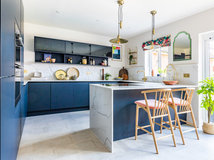
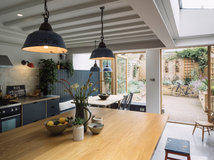


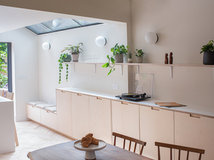

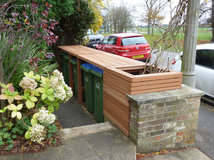
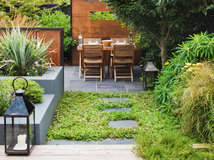
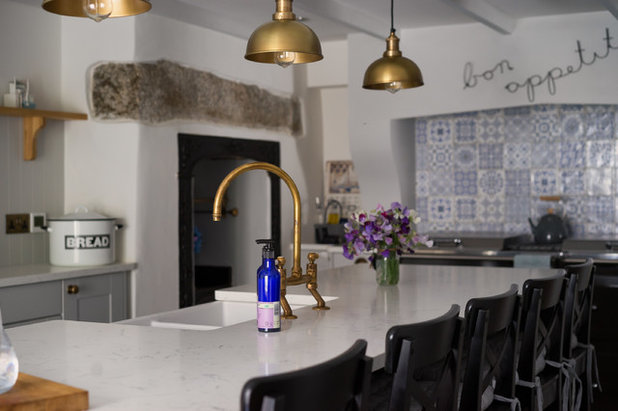
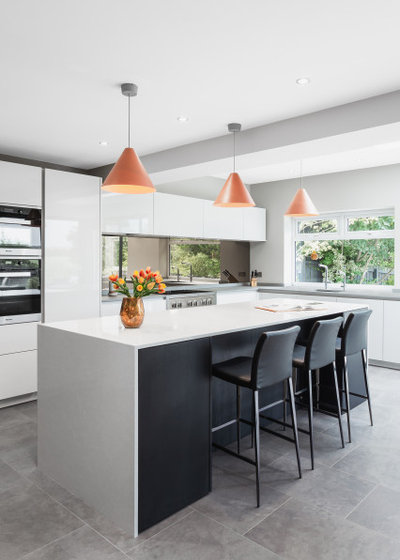
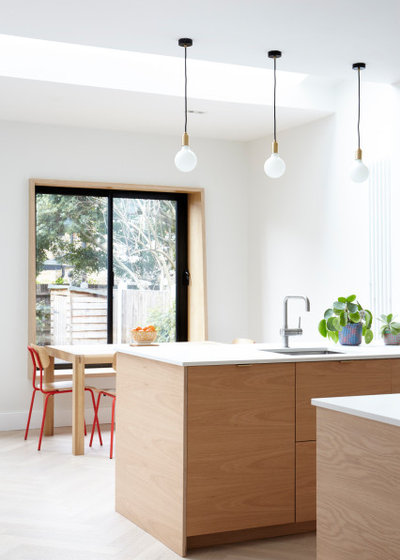
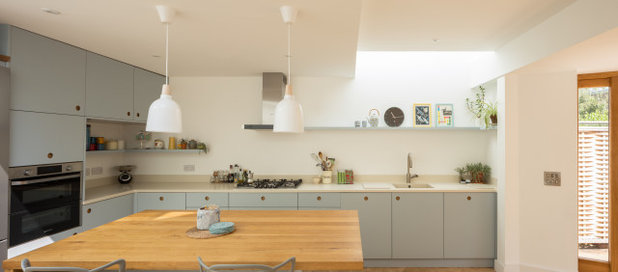
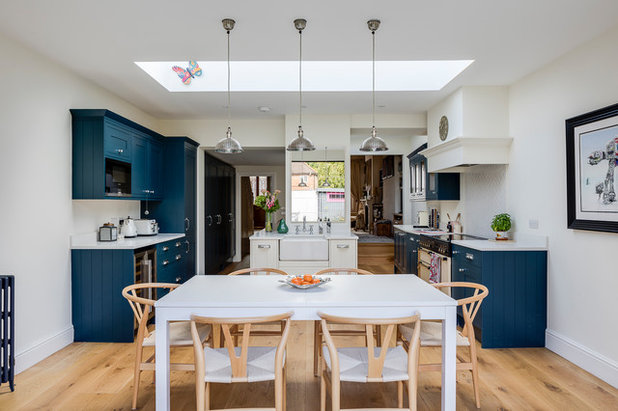
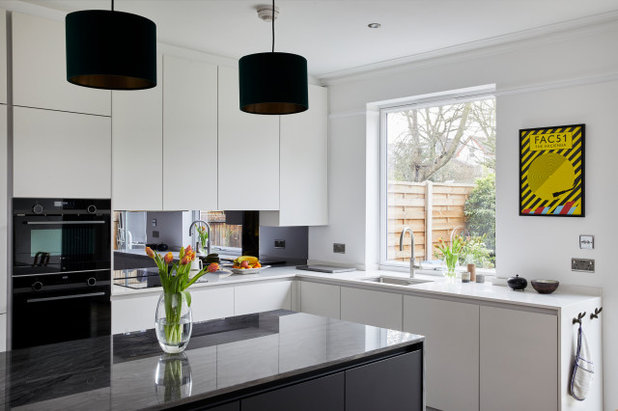
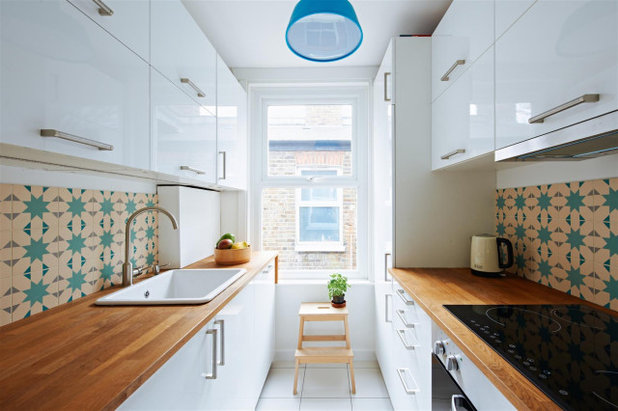
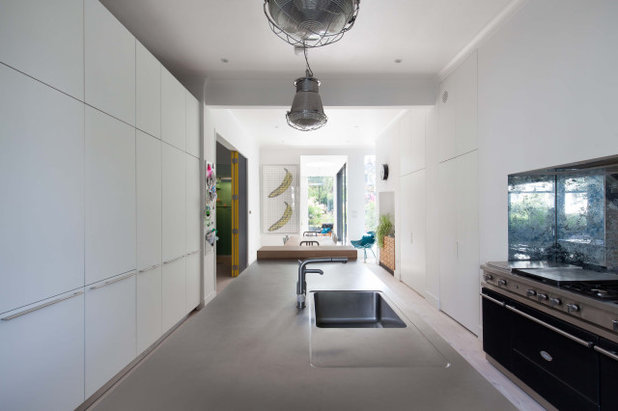

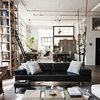
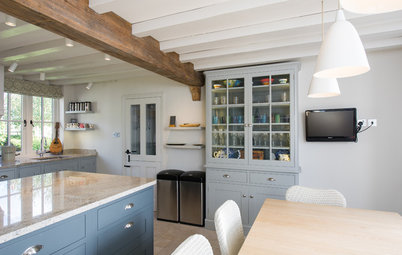
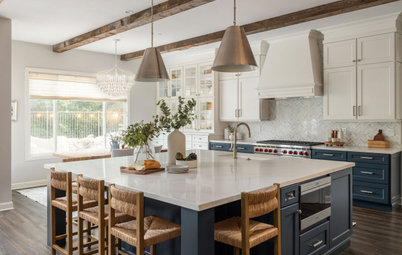
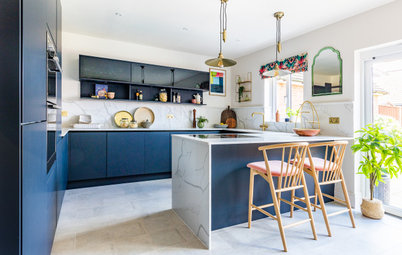
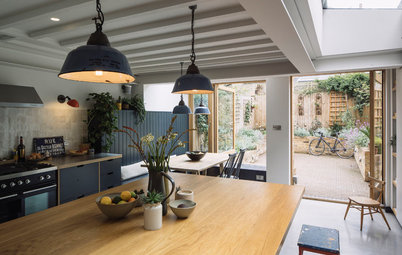
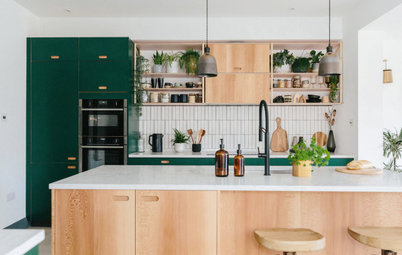
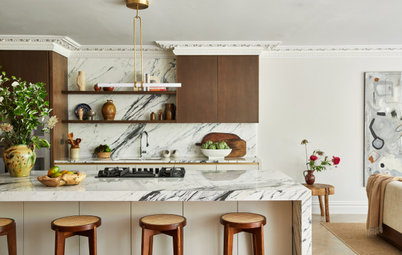
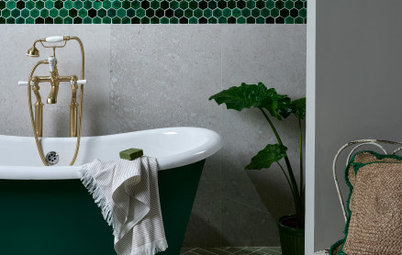
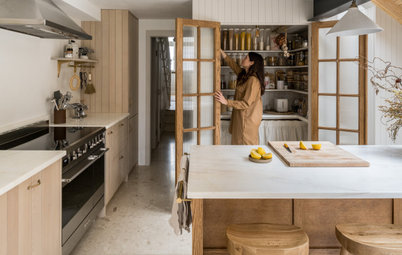
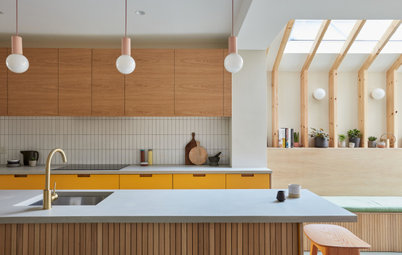
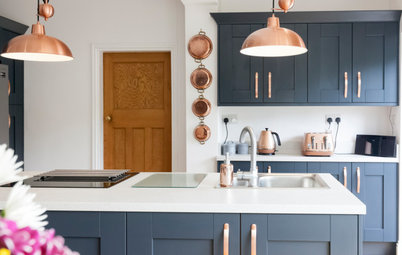
I agree with Liz Sloan - when I’m cooking, I can’t also chat to people. When I’ve attempted this, it’s led to some interesting mistakes….
As I’ve mentioned before, unless your hob, sink and fridge are in a straight line, they’re going to form a triangle! What’s important is that there shouldn’t be interruptions to this flow, such as the way to the back door!! (Yes, we’ve had this, and we’re now getting the whole kitchen redone.) Ironically, the currently popular island appears in some cases to be the block you want to avoid!
Sink by the wall as never use it with a dishwasher. I have three plug-in hobs so they can go anywhere. Means they don’t take up space on the worktop.